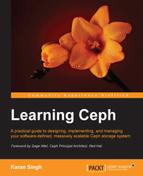In this chapter, we will cover the following topics:
- Ceph storage architecture
- Ceph RADOS
- Ceph Object Storage Device (OSD)
- Ceph monitors (MON)
- librados
- The Ceph block storage
- Ceph Object Gateway
- Ceph MDS and CephFS
A Ceph storage cluster is made up of several different software daemons. Each of these daemons takes care of unique Ceph functionalities and adds values to its corresponding components. Each of these daemons is separated from the others. This is one of the things that keeps Ceph cluster storage costs down when compared to an enterprise, proprietary black box storage system.
The following diagram briefly highlights the functions of each Ceph component:
Reliable Autonomic Distributed Object Store (RADOS) is the foundation of the Ceph storage cluster. Everything in Ceph is stored in the form of objects, and the RADOS object store is responsible for storing these objects, irrespective of their data type. The RADOS layer makes sure that data always remains in a consistent state and is reliable. For data consistency, it performs data replication, failure detection, and recovery, as well as data migration and rebalancing across cluster nodes.
As soon as your application issues a write operation to your Ceph cluster, data gets stored in Ceph Object Storage Device (OSD) in the form of objects. This is the only component of a Ceph cluster where actual user data is stored and the same data is retrieved when a client issues a read operation. Usually, one OSD daemon is tied to one physical disk of your cluster. So, in general, the total number of physical disks in your Ceph cluster is the number of OSD daemons working underneath to store user data to each physical disk.
Ceph monitors (MONs) track the health of the entire cluster by keeping a map of the cluster state, which includes OSD, MON, PG, and CRUSH maps. All the cluster nodes report to monitor nodes and share information about every change in their state. A monitor maintains a separate map of information for each component. The monitor does not store actual data; this is the job of OSD.
The librados library is a convenient way to get access to RADOS with the support of the PHP, Ruby, Java, Python, C, and C++ programming languages. It provides a native interface to the Ceph storage cluster, RADOS, and a base for other services such as RBD, RGW, as well as the POSIX interface for CephFS. The librados API supports direct access to RADOS and enables you to create your own interface to the Ceph storage cluster.
Ceph Block Device, formerly known as RADOS block device (RBD), provides block storage, which can be mapped, formatted, and mounted just like any other disk to the server. A Ceph block device is equipped with enterprise storage features such as thin provisioning and snapshots.
Ceph Object Gateway, also known as RADOS gateway (RGW), provides a RESTful API interface, which is compatible with Amazon S3 (Simple Storage Service) and OpenStack Object Storage API (Swift). RGW also supports the multitenancy and OpenStack Keystone authentication services.
Ceph Metadata Server (MDS) keeps track of file hierarchy and stores metadata only for CephFS. A Ceph block device and RADOS gateway do not require metadata, hence they do not need a Ceph MDS daemon. MDS does not serve data directly to clients, thus removing a single point of failure from the system.
Ceph File System (CephFS) offers a POSIX-compliant, distributed filesystem of any size. CephFS relies on Ceph MDS to keep track of file hierarchy, that is, metadata. CephFS is not production ready at the moment, but it's an idle candidate for POC tests. Its development is going at a very fast pace, and we can expect it to be in production ready very soon.
